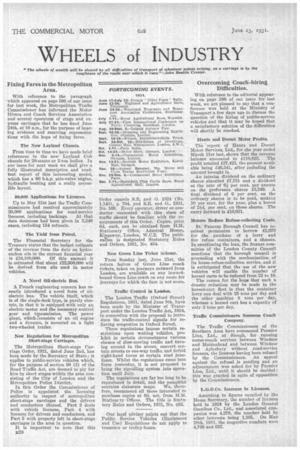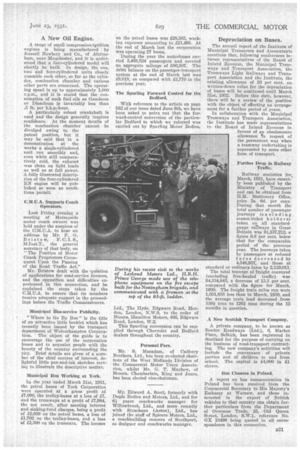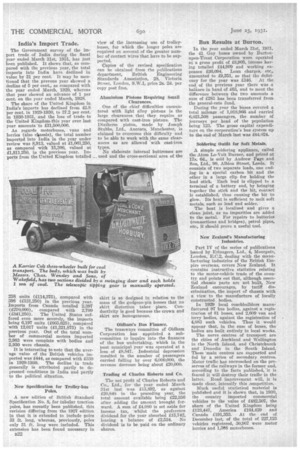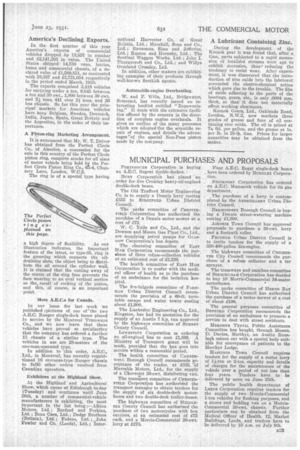WHEELS of INDUSTRY
Page 34

Page 35

Page 36

Page 37

If you've noticed an error in this article please click here to report it so we can fix it.
"The wheels of wealth will be slowed by all difficulties of transport at whatever paints arising, as a carriage is by the
roughness of the roads over which it runs."—John Beattie Crozier.
Fixing Fares in the Metropolitan Area.
With reference to the paragraph which appeared on page 598 of our issue for last week, the Metropolitan Traffic Commissioner has informed the Motor Hirers and Coach Services Association and several operators of stage and express carriages that he has fixed Jane 24th, at 10 a.m., for the purpose of hearing evidence and receiving representations with the hope of fixing fares.
The New Leyland Chassis.
From time to time we have made brief references to the new Leyland Cub chassis for 20-seater or 2-ton bodies. In our issue for next week we shall give a fully illustrated description and roadtest report of this interesting model, which has a 60 b.h.p. side-valve engine, hydraulic braking and a really accessible layout.
30,000 Applications for Lieenees.
Up to May 31st last the Traffic Commissioners had received approximately 30,000 applications for road-service licences, including backings. At that date decisions had been given in 3,249 eases, including 154 refusals. • The yield from Petrol.
The Financial Secretary for the Treasury states that the budget estimate of the revenue from the duty on hydrocarbon oils in the current financial year is £24,100,000. Of this amount it is estimated that about £22,500,000 will be derived from oils used in motor vehicles.
A Novel Oil-electric Bus.
A French engineering concern has recently introduced a novel form of oilelectric bus. The vehicle itself, which is of the single-deck type, is purely electric, in that it is equipped with only an electric motor and the necessary control gear and transmission. The power plant, which.tconsists of an oil engine and a dynamo, is mounted on a light two-wheeled trailer.
New Regulations for Metropolitan Short-stage Carriages.
The Metropolitan Short-stage Carriage Order, 1931, dated June 2nd, has been made by the Secretary of State ; it applies to public-service vehicles which, for the purpose of section 99 (2) of the. Road Traffic Act, are deemed to ply for hire by short stages within the area consisting of the City of London and the Metropolitan Police District.
In this Order the Commissioner of Police is appointed the licensing authority in respect of metropolitan short-stage carriages and the drivers and conductors thereof. Part 3 deals with vehicle licences, Part 4 with licences for drivers and conductors, and Part 5 with property left in short-stage carriages in the area in question.
It is important to note that this Js20
Order cancels S.R. and 0. 1924 (No. 1.149), p. 704, and SR. and 0., 1931, No. 169. Every operator, driver or conductor connected ' with this class of traffic should be familiar with the requirements of this Order. Copies, price 6d. each, can be obtained from 11.111. Stationary Office, Adastral House, Kingsway, London, W.C.2: The publication is designated Statutory Rules and Orders, 1931, No. 454.
New Green Line Ticket Scheme.
From Sunday last, June 21st, the return halves of Green Line coach tickets, taken on journeys outward from London, are available on any inwardbound Green Line coach on any route for journeys for which the fare is not more.
Traffic Control in London.
The London Traffic (Oxford Street) Regulations, 1931, dated June 9th, have 'been made by the Minister of Transport under the London Traffic Act, 1924, in connection with the proposal to introduce the traffic-control signals for relieving congestion in Oxford Street These regulations impose certain restrictions upon waiting vehicles, prohibit in certain circumstances various classes of slow-moving traffic and turning around in the street, convert certain streets to one-way traffic, and forbid right-hand turns at certain road junctions. Whilst the regulations came into force yesterday, it is not proposed to bring the signalling system into operation until July.
The regulations are far too long to be reproduced in detail, and the pamphlet
contains elaborate maps. We, therefore, recommend all those interested to purchase copies at 6a. net, from H.M. Station( ry Offices. The title is Statutory Rules and Orders,. 1931, No. 482.
Our legal adviser points out that the Public. Service Vehicles (Equipment and Use) Regulations do not apply to tramcars or trolley-buses.
Overcoming Coach-hiring Difficulties.
With reference to the editorial appearing on page 596 of our issue for last week, we are pleased to say that a conference was held at the Ministry of Transport a few days ago to discuss the question of the hiring of public-service vehicles and that it may be hoped that a satisfactory solution of the difficulties will shortly be reached.
Hants and Dorset Motor Profits.
The report of Hants and Dorset Motor Services, Ltd., for the year ended March 31st last, shows that the revenue balance amounted to £110,823. The profit totalled £37,423, the amount available being £46,341, after including the amount brought in.
. An interim dividend on the ordinary shares absorbed £7,751 and a dividend at the rate of 61 per cent, per annum on. the preference shares £3,349. A final dividend of 6 per cent. on the ordinary shares is to be paid, making 10 per cent. for the year, plus a bonus of aid. per cent on those shares. The carry forward is £10,021.
Motors Reduce Refuse-collecting Costs.
St. Pancras Borough Council has received permission to borrow £2,670 for the purchase of a lorry and five refuse containers, and a chassis. In sanctioning the loan, the finance committee of the London County Council mentions that the borough council is proceeding with the mechanization of its house-refuse-collection service, and it is anticipated that the use of the new vehicles will enable the number of horsed carts to be reduced from 22 to 10.
The reason for the hope that such a drastic reduction may be made in the horsed-cart fleet is that the container lorry can deal with 25 tons per day and the other machine 8 tons per day, whereas a horsed cart has a capacity of only 3 tons per day.
Traffic Commissioners Summon Coach Company.
The Traffic Commissioners of the Southern Area have summoned Premier Line, Ltd., at Slough, for running motor-coach services between Windsor and Maidenhead and between Windsor and Aylesbury without road-service licences, the licences having been refused by the Commissioners. An appeal against the refusal is pending and an adjournment was asked for by Premier Line, Ltd., until it should be decided ; this was granted in spite of opposition by the Commissioners.
L.G.O.Co. Increase in Licences.
According to figures supplied by the Home Secretary, the number of licences held in 1924 by the London General Omnibus Co., Ltd., and •associated companies was 4,279, the number: held by other interests being 1,105. On May 20th, 1981, the respective numbers were 4,766 and 687.
A New Oil Engine.
A range of small compression-ignition engines is being manufactured by Russell Newbery •and Co., of Altrincham, near Mauchester, and it is understood that a four-cylindered model will shortly be built. In design, the one, two and four-cylindered units closely resemble each other, so far as the cylinder, combustion chamber and various other parts are concerned. The operating speed is up to approximately 1,000 r.p.m., and it is stated that the consumption of such fuel oils as Gasoleum or Diesoleum is invariably less than .5 lb. per b.h.p.-hour.
A particularly robust crankshaft is used and the design generally inspires confidence. At the moment details of the combustion chamber cannot be divulged owing to the patent position, but it may be said that in a demonstration at the works a single-cylindered unit ran smoothly and, even while still comparatively cold, the exhaust was clean on light loads as well as at full power. A fully illustrated description of the four-cylindered RN engine will be published so soon as conditions. permit.
Supports Coach Operators.
Last Friday evening a meeting of Merseyside motor coach owners was held under the auspices or the am.u.A. to hear an address by Mr. F., G. Bristow, F.C.I.S., M.Inst.T., the general secretary of that body, on "The Position of Motor Coach Proprietors Censeanent Upon the Passing of the Road Traffic Act."
• Mr. Bristow dealt with the 'question of applications for road-service licences, and the opposition and difficulties experienced in this connection, and he explained the steps taken by the C.M.U.A. to ensure that its members receive adequate support in the proceedings before the Traffic Commissioners.
Municipal 13ns-service Publicity.
"Where to Go By Bus" is the title of an attractive little booklet which has recently been issued by the transport department of Wolverhampton Corporation. The object of the guide is to encourage the use of the corporation buses and to acquaint people with the beauty of the country surrounding the city. Brief details are given of a number of the chief centres of interest, delightful little perk-and-ink sketches serving to, illustrate the descriptive matter.
Municipal Bus Working, at York.
In the year ended March 31st, 1931, the petrol buses of York Corporation were operated at a gross profit of £7,090, the trolley-buses at a loss of £7, and the tramways at a profit of £7,984, the net result, after meeting interest and sinking-fund charges, being a profit of £2,030 on the petrol buses, a loss of £1,702 on the trolley-buses, and a loss of £2,300 on the tramcars. The income on the petrol buses was £28,585, working expenses amounting to,.£21,495. At the end of March last the corporation was operating 27 buses.
During the year the motorbuses carried 3,468,524 passengers and covered an aggregate mileage of 686,507. The debit balance oh the passenger-transport system at the end of March last was 18.018, as compared with f3,770 in the previous year.
The Spurling Forward Control for the Bedford.
With reference to the article on page 582 of our issue dated June 9th, we have been asked to point out that the forward-control conversion of the particular Bedford to which we referred was carried out by Snarling Motor Bodies,
Ltd., The Hyde, Edgware Road, Hendon, London, N.W.9, to the order of Messrs. Hamilton' Motors, 466, Edgware Road, London, W.2.
This Spurling conversion can be supplied through Chevrolet and Bedford dealers throughout the country.
Personal Pars.
Mr. S. Macadam, of Cadbury Brothers, Ltd., has been re-elected chairman of the West Midlands Division of the Commercial Motor Users Association, whilst Mr. G. T. Mayhew, of Messrs. Chamberlain, King and Jones, has been elected vice-chairman.
Mr. Edward A. Scott, formerly with Duple Bodies and Motors, Ltd., and for 6} years coachworks maeager for Willowbrook, Ltd., and more recently with Strachans (Acton), Ltd., has joined the staff of SpicersMotors. Ltd., a coachbuilding concern of Southport, as designer and coachsvorks manager.
Depreciation on Buses.
The annual report of the Institute of Municipal Treasurers and Accountants mentions that, following conferences between representatives of the Board of Inland Revenue, the Municipal Tramways and .Transport Association, the Tramways Light Railways and Transport Association and the Institute, the existing allowance of 20 per cent. on written-down value for the depreciation of buses will be continued until March 31st, 1932. Before this date, however, there will be a review of the position with the object of effecting an arrangement for a further period of years.
In collaboration with the Municipal Tramways and Transport Association, the Institute has made representations to the Board of Inland Revenue in favour of an obsolescence allowance 'In respect of the permanent way when a tramway undertaking is superseded by some other form of transport.
Further Drop in Railway Traffic.
Railway statistics for March, 1931, have recent: ly been published by the Ministry of Transport and can be obtained from H.M. Stationery Office, price 2s. 6d. per copy. During that month the total number of passenger journeys (excluding season-ticket holder s) taken on all standardgauge railways in Great Britain was 91,137,212, a figure 6.8 per cent, below that for the comparable period of the previous year. The journeys taken by passengers at reduced fares decreased by 4,546,937, and those at standard or ordinary fares by 2,129,011.
The total tonnage of freight conveyed (excluding free-hauled traffic) was 24,334,843, a decrease of 13.3 per cent. compared with the figure for March, 1930. The freight train miles run were 1,051,838 less than in March, 1930, and the average train load decreased from 180k tons to 126+ tons during the 12 months in question.
A New Scottish Transport Company.
A private company, to be known as Border Roadways (Ltd.), 6, Market Place, Selkirk, has been registered in Scotland for the purpose of carrying on the business of road-transport contracting. The new company's activities will include the conveyance of private parties and of children to and from school. The capital is .£4,000 in shares.
Bus Chances in Poland.
A report on bus communication in Poland has been received from the Commercial Secretary to His Majesty's Embassy at Warsaw, and those interested in the export of British vehicles to that country can obtain further particulars from the Department of Overseas Trade, 35, Old Queen Street, London, S.W.1, reference No. GX 10499 being quoted in all correspondence in this connection. India's Import Trade.
The Government survey of the import trade of India during the fiscal year ended March 31st, 1931, has just been published. It shows that, as compared with the previous year, the total imports into India have declined in Value by 31 per cent. It may be mentioned that the prevous year showed a decline of 5 per cent., as compared with the year ended March, 1929, whereas that year showed an advance of 1 per cent. on the year ended March, 1928.
The share of the United Kingdom in India's imports has declined from 42.8 per cent. in 1929-1930, to 37.2 per cent. in 1930-1931, and the loss of trade to the United Kingdom-this year over last year amounts to £31,500,000.
As regards motorbuses, vans and lorries (also chassis), the total number imported into India in the year under review was 8,913, valued at £1,061,250, as compared with 15,306, valued at £1,811,250, in the previous year. Imports from the United Kingdom totalled
258 units (£114,375), compared with 398 (£131,250) in the previous year. Imports from Canada totalled 2,397 (£270,000), compared with 2,799
(341,250). The United States suffered even more severely, the imports being 6,197 units (£665,625), compared with 12,017 'units (£1,321,875) in the previous year. Out of the total number of commercial motors imported 2,983 were complete with bodies and 5,930 were chassis.
It is interesting to note that the average value of the British vehicles imported was £444, as compared with £330 1929-1939. The decline in trade generally is attributed partly to depressed conditions in India and partly to the political situation.
New Specification for Trolley-bus Poles.
A new edition of British Standard Specification No. 8, for tubular traction poles, has recently been published, this revision differing from the 1927 edition in that it is extended to include poles 33 ft. long, whereas, previously, poles only 31 ft. long were included. This extension has been found necessary in n22
view of the increasing use of trolleybuses, for which the longer poles are required on account of the greater number of contact wires that have to be supported.
Copies of the revised specification can be obtained from the publications department, British Engineering Standards Association, 28, Victoria Street, London, SAVA, price 2s. 2d. per copy post free.
Aluminium Pistons Requiring Small Clearances.
One of the chief difficulties encountered with light alloy pistons is the large clearances that they require as compared with cast-iron pistons. The Di atherm piston, made by Joseph Stubbs, Ltd., Ancoats, Manchester, is claimed to overcome this difficulty and to be able to work with the same clearances as are allowed with cast-iron types.
No elaborate internal buttresses are __used and the cross-sectional area of the
skirt is so designed in relation to the mass of the gudgeon-pin bosses that no skirt distortion takes place. Conductivity is good because the crown and skirt are homogeneous.
Oldham's Bus Finance.
The tramways committee of Oldham Corporation has appointed a subcommittee to inquire into the finances of the bus undertaking, which in the Past municipal year was operated at a loss of £8,347. Industrial depression resulted in the number of passengers carried falling by over 0,000,000, the revenue decrease being about £20,000.
Trading of Charles Roberts and Co.
The net profit of Charles Roberts and Co., Ltd., for the year ended March 31st last was £13,892, as against £20,848 in the preceding year, the total amount available being £22,356 after adding the amount brought forward. A sum of £4,080 is set aside for income tax, whilst the preference dividend for the year absorbed £15,742, leaving a balance of £2,534. No dividend is to be paid on the ordinary shares. Bus Results at -Burton.
In the year ended March 31st, 1931, the 41 Guy buses owned by Burtonupon-Trent Corporation were operated at a gross profit of £8,905, income having totalled £44,999 and working ex
penses £36,094. Loan charges, etc., amounted to £9,251, so that the deficiency for the year was 1346. At the end of the previous year there was a balance in hand of 103, and to meet the difference between the two amounts a sum of £283 has been transferred from the general-rate fund.
During the year the buses covered a total mileage of 1,018,966 and carried 6,021,508 passengers, the number of journeys per head of the population being 123. The gross capital expenditure on the corporation's bus system up to the end of March last was £64,024.
Soldering Outfit for Soft Metals.
A simple soldering appliance, called the Atom Lo-Volt Burner, and priced at 17s. 64., is sold by Andrew Page and Son, Ltd., 99, Albion Street, Leeds. It consists of two separate leads, one ending in a special carbon bit and the other in a large clip for holding the lead stick. Each lead is clipped to a terminal of a battery and, by bringing together the .stick and the hit, contact is established, thus causing the bit to glow. Its heat is sufficient to melt soft metals, such as lead and solder.
The heat is localized and gives a clean joint, as no impurities are added to the metal. For repairs to batteries (connections and bridges), petrol pipes, etc., it should prove a useful tool.
New Zealand's Manufacturing Industries.
Part IV of the series of publications issued by Erlaugers, Ltd., 4, Moorgate,
London, E.C.2, dealing with the manu
facturing industries of the British Empire overseas, covers New Zealand. It
contains instructive statistics relating to the motor-vehicle trade of the country and points out that, although essential chassis parts arc not built, New Zealand encourages, by tariff discrimination, the import of chassis with a view to the manufacture of locally constructed bodies.
In 1929 local coachbuilders manufactured 97 bus bodies, against a registration of 81 buses, and 2,609 van and lorry bodies, against the registration of 4,083 such vehicles. Thus it would appear that, in the case of buses, the bodies are built entirely in local works.
The nerve centres of transport are the cities of Auckland and Wellington in the North Island, and Christchurch and Dunedin in the South Island. These -main centres are supported and fed by a series of secondary centres. Motor traffic has encroached on the preserves of the railways in the former and, according to the facts published,'it is feared it will destroy their traffic in the latter. Road improvement will, it is made clear, intensify this zompetition.
Much useful statistical material is Published and it is shown that, in 1930, the country imparted commercial vehicles to the value of £482,507, the share of the United Kingdom being £123,447, America £164,429 and Canada 1191,353. At the end of December last, of the total of 227,123 vehicles registered, 30,967 were motor lorries and 1,3t8 motorbuses.
America's Declining Exports.
In the first quarter of this year America's exports of commercial vehicles dropped by 13,857 in number and £2,141,203 in value. TM United States shipped 14,730 vans, lorries, buses and commercial chassis, of a declared value of £1,589,851, as contrasted with 28,587 and £3,731,054 respectively in the period ended March, 1930.
The exports comprised 3,418 vehicles. for carrying under a ton, 9,045 between a ton and 30 cwt., 1,800 between 30 cwt. and 2; tons, 441 over 21 tons, and 26 bus chassis. So far this year the principal markets for American vehicles have neen Belgium, Sweden, Denmark, India, Japan, Spain, Great Britain and the Argentine, in the order of their importance.
A Piston-ring Marketing Arrangement.
It is announced that Mr. W. T. Driver has obtained from the Perfect Circle Co., of America, a concession for the sale in this country of the Perfect Circle piston Ting, complete stocks for all sizes of motor vehicle being held by the Perfect Circle Piston Ring Co., 6-4, Chancery Lane, London, W.C.2.
The ring is of a special type having a high degree of flexibility. As our illustration indicates, the important feature of the latest, or type-85, ring is the grooving which connects the oildraining slots, the object being to distribute the oil around the cylinder wall. It is claimed that the cutting away of the centre -of the ring face prevents the face wearing to an oval vertical section as the,result of rocking of the piston, and this, of course, is an important Point More A.E.C.s for Canada.
In our issue for last week we published pictures of one of the two A.E.C. Ranger single-deck buses placed ia service by the Montreal Tramways Co., and we now learn that these vehicles have proved so eatisfacttry that the company has ordered a further 15 chassis of a similar type. The vehicles in use are 28-seaters of the one-man-operated type.
In addition to this order, A.E.C., Ltd., in Montreal, has recently requisitioned 16 overseas-type `Banger chassis to fulfil other orders received from Canadian operators.
Exhibitors at the Highland Show.
At the Highland and Agricultural Show, which opens at Edinburgh to-day (Tuesday) and continues until June 26th, a number of commercial-vehicle manufacturers is exhibiting, the most important in the list being :--Albion Motors, Ltd.; Barford and Perkins, Ltd.; Bean Cars, Ltd.; Dodge Brothers (Britain), Ltd.; Fodens, Ltd. ;,John Fowler and Co. (Leeds), Ltd.; Inter
national Harvester Co. of Great Britain, Ltd.; Marshall, Sons and Co., Ltd.; Ransomes, Sims and Jefferies, Ltd.; Ruston and Hornsby, Ltd. ; The Sentinel Waggon Works, Ltd.; John I. Thornycroft and Co., Ltd.; and Willys Overland Crossley, Ltd.
In addition, other makers are exhibiting examples of their products through well-known Scottish agents.
Automobile-engine Overhauling.
W. and P. Wills, Ltd., Bridgwater, Somerset, has recently issued an interesting booklet entitled " Repowerising." It deals with the extensive facilities offered by the concern in the direction of complete engine overhauls. It gives an outline of-the many processes which are adopted4f or the scientific repair of engines, and details the advantagee—of the special Non-Pass piston made by the company.
A Lubricant Containing Zinc.
During the development of the Keenok gear it was found that, after a time, parts subjected to a rapid succession of localiz'ed stresses were apt to exhibit corrosion, thus? reducing the tendency to resist wear. After experiment, it was discovered that the introduction of zinc oxide into the lubricant prevented the electro-chemical action which gave rise to the trouble. The film of oxide adhering to the parts of the bearings, gears, etc., is only .0004 mm. thick, so that' it does not materially affect working clearances.
Keenok Gears, Ltd., Oaklands Road, London, N.W.2, now markets three grades of grease and four of oil containing zinc oxide. The oil is priced at 7s, 6d. per gallon, and the grease at is. per lb. in 28-1.0. tins. Prices for larger quantities may be obtained from the maker.




























































































